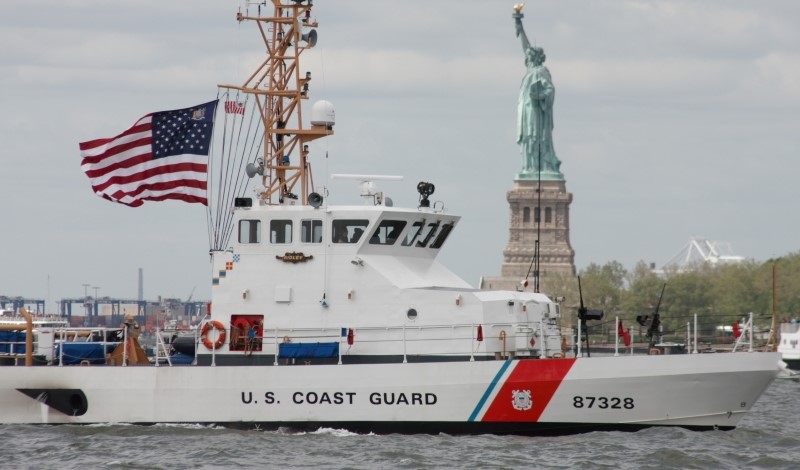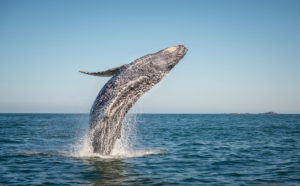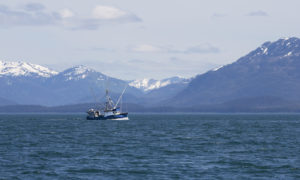
New maritime risks necessitate further strategic review of the Coast Guard’s legal authority and mission support capabilities.
Over the coming decade, the U.S. Coast Guard will face a broad range of new challenges stemming from climate change, rapid technological innovation, and global political, military, and economic competition. Because the Coast Guard’s responsibilities are extremely broad—spanning a range of safety, security, and environmental quality missions in the maritime domain—the agency can expect a correspondingly broad range of challenges in the years ahead.
In 2021, Congress called for a study by the National Academies of Sciences, Engineering and Medicine (NASEM) to identify the “emerging issues” that will demand Coast Guard “oversight, regulation, or action” over the next decade—and then to assess any “potential limitations and shortcomings” in the Coast Guard’s legal authority to respond to these new risks.
Recently, NASEM issued its findings from this congressionally mandated study. The study committee, which I chaired, identified 10 major developments affecting the maritime domain that will pose new or increasing challenges to the Coast Guard in the next 10 years. These developments include the introduction of autonomous vessels, the increasing presence of cybersecurity risks, and safety concerns related to commercial spaceflight operations operating in and beyond U.S. territorial waters.
New challenges will also arise from the opening up of the Arctic domain and from growth in offshore wind energy, aquaculture, and alternative-fueled vessels. These various challenges will come on top of other challenges presented by disasters, migration, and illegal, unreported, and unregulated fishing.
In the face of all these emerging challenges, many of which have already started to manifest, will the Coast Guard have the statutory authority it needs to protect the public?
In the wake of recent U.S. Supreme Court decisions articulating a “major questions doctrine,” the adequacy of agencies’ statutory authority has taken on increased salience across the federal government. And with the Court hearing a case this term that might lead to a retreat from judicial deference under the Chevron doctrine, the importance of ensuring that the Coast Guard and other agencies possess clearly articulated statutory authority may only increase if the U.S. government is to be able to deal with future challenges.
The NASEM committee’s bottom-line answer about the Coast Guard’s statutory authority can be considered good news: The service likely possesses sufficient statutory authority to take the kinds of actions needed to respond to most of the foreseeable challenges ahead. But we did identify a few crucial areas in likely need of congressional attention. Perhaps even more importantly, we found that, beyond statutory authority, the U.S. Congress and the Coast Guard will need to work to strengthen the service’s mission support and strategic foresight capacities to meet the demands of the future.
Determining whether any agency has the statutory authority it needs to meet future challenges is a daunting task. It requires future-oriented operational thinking as well as proverbial thinking “like a lawyer.” Making a statutory authority determination could hardly be more daunting for an agency like the Coast Guard, which is both a military service with defense responsibilities and an agency within the Department of Homeland Security that plays a host of nonmilitary roles. In fact, according to the Homeland Security Act of 2002, the Coast Guard performs 11 major missions, ranging from its well-known search-and-rescue operations to responsibilities as varied as drug interdiction, fisheries law enforcement, and ice operations.
To know whether an agency with such a varied mandate possesses the statutory authority needed to meet future challenges, it is necessary to identify not only emerging developments in its domain but also the different types of actions it will likely need to take in response. Only after identifying nearly three dozen types of response actions the Coast Guard would likely need to take could those of us on the NASEM study committee even start to consider whether the Coast Guard’s existing statutory authority would likely be adequate.
Our study committee had deep expertise on which to draw. Among its membership, for example, included four retired Coast Guard and Navy flag officers. We undertook a nearly 17-month process to gather extensive information from senior Coast Guard leaders and other officials as well as input from more than 50 outside experts.
With respect to each type of action we determined the Coast Guard would need to take to meet the challenges we identified, we methodically asked: Does the action clearly fall under the Coast Guard’s existing authority? Is the action specifically precluded under existing law? Are there obvious instances where authority to act is missing, insufficient, unduly restricted, or substantially in need of clarification?
In the end, we did not find many gaps or obstacles. As we put it in our final report, “the Coast Guard is already bestowed with much statutory authority to act, including authority that affords the Coast Guard latitude to take a wide range of actions, both existing and new.”
But we did find two limited exceptions to this general conclusion, and we saw one additional area where statutory change, while not absolutely essential, may be prudent.
When it comes to autonomous vessel technology, the Coast Guard has much authority already to take many regulatory steps to protect the maritime transportation system from any risks associated with this new technology. But if, or when, fully autonomous vessels are safe enough for general use by shipping companies and other maritime operators, the Coast Guard will be unable to authorize uncrewed vessels because current statutes call for vessels to have “watchmen” and “pilots” on board. A recent congressionally authorized pilot program does allow waivers for uncrewed vessels in the limited context of commercial space operations. But at some point Congress may need to modify statutory requirements more broadly or at least give the Coast Guard general authority to waive existing requirements when appropriate.
With respect to commercial space operations, the Coast Guard again has much statutory authority. It can and does establish mandatory safety zones around launch and reentry sites in U.S. territorial waters and with respect to U.S.-flagged vessels in any waters. But as space operations move farther to sea, the Coast Guard lacks statutory authority to impose binding safety orders on foreign-flagged vessels outside of territorial waters. Although the Coast Guard can issue warnings that ships from other nations should stay out of range when space launches and landings are taking place, it lacks the authority to take forceful measures to keep foreign-flagged ships away from spaceflight operations taking place beyond territorial waters. This limitation is reflected in statutory law, but it also stems crucially from a parallel limitation in international law, which protects freedom of navigation for foreign-flagged vessels outside of a country’s own waters.
So too, it should be noted, are there international law counterparts with respect to the issue of fully autonomous vessels. International conventions contain “manning” requirements similar to those in U.S. statutory law. As a result, congressional action related to either autonomous systems or commercial space operations will need to be coordinated with appropriate modifications of international legal standards. The International Maritime Organization (IMO)—a United Nations agency—is well aware of these issues already. Changes in international standards are quite plausible in the years ahead. Through its representation on the IMO Council as well as through its continued involvement in IMO policy development processes, the United States should seek to ensure any domestic statutory reforms remain in sync with international law reforms.
With respect to a third major development confronting the maritime sector—cybersecurity—the wording within current statutes is broad enough to give the Coast Guard authority to act to prevent and respond to cyberattacks. But prudence may still dictate statutory change. In 2021, Congress amended the Ports and Waterways Safety Act to affirm that the authority this law grants the Coast Guard to deal with security risks also encompasses cyber incidents. Having affirmed that one security-related statute specifically covers cybersecurity, it may be time for Congress to do the same for other maritime security statutes, namely the Maritime Transportation Security Act and the Magnuson Act of 1950.
Still, except for these three issues—autonomous vessels, commercial spaceflight, and cybersecurity—the Coast Guard generally possesses the statutory authority it needs for the issues we identified emerging over the coming decade.
But is statutory authority by itself enough?
Emerging developments in the maritime sector pose challenges to the Coast Guard that are both demanding and dynamic. Technology is developing rapidly, climate change is quickly reshaping coastlines and altering environmental conditions, and geopolitics remains in considerable flux. The challenges the Coast Guard confronts over the next 10 years will place new and increasing demands on the service, at the same time that the service must continue to meet more long-standing security, safety, and environmental stewardship needs.
To meet its looming challenges, the Coast Guard will need more than just statutory authority. It will also need to enhance its mission support capabilities, including its ability to manage and analyze data, nimbly procure needed technology, and maintain workforce readiness in an era of advancing digital technology. After all, without the personnel and technology needed to prioritize, manage, and respond to risks, statutory authority will amount to little more than words on paper.
Mission support capabilities and capacities will be so crucial to the Coast Guard’s performance over the next 10 years that the NASEM study committee devoted an entire chapter in its report to detailing these needs. For example, if the Coast Guard is to improve and expand its law enforcement and security roles—whether to combat cybersecurity, track new traffic in the Arctic region, or combat illegal fishing—it will need more and better data on a host of activities in the maritime domain. Just as importantly, it must have the advanced digital technology to manage and process these data to make them actionable. New ways of integrating data from private actors will likely be beneficial too, such as by making use of sensors on offshore wind turbines to promote maritime domain awareness.
More data and better technology will be of limited value, of course, without a Coast Guard workforce that can make use of them intelligently. Private actors in the maritime sector are rapidly advancing in their use of data and artificial intelligence tools. It only makes sense that, to keep pace, the Coast Guard will need to build up its human capital and organizational capacity to design and operate its own systems that can oversee the maritime digital ecosystem and prevent, as well as respond to, cyber threats.
The Coast Guard is working on these issues. But congressional action will be needed too—not only to provide necessary budgetary resources but also potentially to adjust certain management-related statutory provisions, whether related to personnel or to procurement, that inhibit suitably rapid adaptive responses by the Coast Guard.
In addition, because the Coast Guard must remain vigilant and ready to adapt, the service will benefit from strengthening its strategic planning process—the so-called Evergreen process that it established over 20 years ago. As we made clear in the NASEM study report, it will be vital for the Coast Guard to give strategic foresight a “high priority”—both by broadening it to include a fuller range of foresight methods and by institutionalizing it as a continuous process, rather than having it just remain a series of “ad hoc, periodic exercises conducted to inform leadership transitions.”
At the same time, the Coast Guard would do well to build legal analysis explicitly into its strategic planning. Even though the Coast Guard already has most of the statutory authority needed to meet the likely challenges of the next decade, this is no guarantee that new, unanticipated needs for statutory authority will not arise. Nor is it a guarantee that the Coast Guard will have sufficient authority two or more decades from now. The Coast Guard should not wait for another congressionally mandated study down the road to keep better tabs on its statutory authority needs.
The NASEM study, and the conceptual framework developed for it, offer a rough template for a process of “legal foresight” that the Coast Guard should build into its strategic planning efforts. After all, it is not only the Coast Guard’s operational environment that will change in the coming years, but so too may its legal environment.
Over the past two years, the Supreme Court has used the major questions doctrine to invalidate executive action in four salient cases involving other federal agencies. The possibility exists that next year the Court will invalidate the Chevron doctrine that has for decades provided federal agencies with flexibility in how they apply their statutory authority. Changes in legal doctrine reinforce the need for all agencies, including the Coast Guard, to initiate regular, institutionalized processes of legal foresight. A robust, institutionalized strategic planning function that includes systemic efforts at legal foresight not only can better prepare the Coast Guard for the future but also better ensure that Congress can take necessary steps to provide the service with any new authority if or when the need should arise.
For now, the Coast Guard seems to have most of the basic authority it needs. But in the face of a rapidly changing maritime domain, it is clear that the Coast Guard will need much more than bare legal authority. Congress must ensure the Coast Guard also has the resources and capabilities needed to act effectively and with agility when navigating the uncharted waters that lie ahead.
This essay originally appeared in Lawfare.




